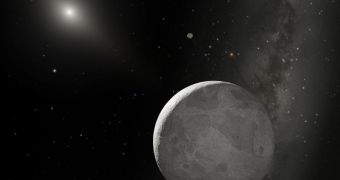The Earth is continuously bombarded by space rocks and small cosmic bodies, probably swallowing up to a few tens of tons of matter each day. Most of these rocks go unnoticed because they burn high up in the atmosphere before reaching the surface of the planet, albeit from time to time larger meteorites and asteroids penetrate all the way to the ground level. Such examples can be found throughout the history; the last known event took place in September last year, when a rocky meteorite fell in Peru. Take the Tunguska event or that of the asteroid that might have killed the dinosaurs, for example.
But even with a lot of rocks able to reach the Earth's ground, there are still little meteorite fragments that are ever recovered from the impact site. Why? You might have noticed last time you looked out of the window that the Earth is slightly different than the other planets in the solar system. I take that back, our planet is unique in the solar system, it is teeming with life! Throw a particular rock over a heavily wooden area, and the chance is you will never hear from it again.
Therefore, one of the best spots to looks for space rocks are large spans of ice water, snow or even salt lake beds. In 2006, two meteorite remnants have been found in the Antarctic continent, most likely both originating in the destruction of a proto-planetary body or a dwarf planet. Scientists argue that the original dwarf planet could have been born somewhere in the asteroid belt, with a high probability that most of the material is still lying in that area.
Gravitational interactions destroyed the proto-planet, but also slingshot some debris over our way. By studying the spectral emissions of light coming from the asteroid belt, the remnant material could be one day identified to confirm the theory.
Missing Dwarf
In the early days of the solar system, when planets were still forming, catastrophic collisions were nothing out of the ordinary. Each impactor contributed with its mass and some amounts of radioactive material which sank and decayed in the cores of the largest objects, determining an excessive heating process that practically covered them - the case of rocky planets - with oceans of magma, some a few hundred kilometers deep, further still allowing heavier elements to sink to the core while the lightest of them were deposited into the outer layers of the planet, through a process called differentiation.
The two stones were dubbed GRA 06128 and GRA 06129, the GRA indicative pointing towards the place where they were discovered, namely Graves Nunataks, Antarctica. While studying the two rocks, planetary astrophysicists discovered that both presented signs of differentiation, thus they can only come from a massive body such as a planet or proto-planet.
Chemical analysis revealed that more than 75 percent of their volume contains a mineral known as feldspar, which only forms on top of magma oceans.
U.S. researchers from the University of Maryland, University of New Mexico and Washington University agree that the fragments can only come from a large body, due to the presence of the differentiation process. The concentrations of feldspar suggest that the body the two could have originated in could have had a diameter slightly smaller than 3500 kilometers, however not smaller than 578 kilometers.
For example, Vesta, which is precisely 578 kilometers wide, does not contain solidified lava, nor relevant concentrations of feldspar which would suggest a differentiation process. "This is a piece of a dwarf-planet size body that apparently no longer exists. We have here a sample of a strange new world, a sample we've never seen before," said Ryan Zeigler of Washington University.
A Piece of History
Part of the class of meteorites called branchinites, the two remnants could only come from a body large enough to go through a partial melting process. The chemical composition analysis clearly shows that they are not indigenous to bodies in the inner solar system, such as the Moon, Venus and so on, and formed some 4.5 billion years ago, when the inner planets were not fully developed yet.
Although it is not clear yet what could have led to the destruction of the original body the fragments came from, the two space rocks can still provide with a unique insight into the solar system's early history, such as whether the parent body contained water, fact proven by the sodium content.

 14 DAY TRIAL //
14 DAY TRIAL //